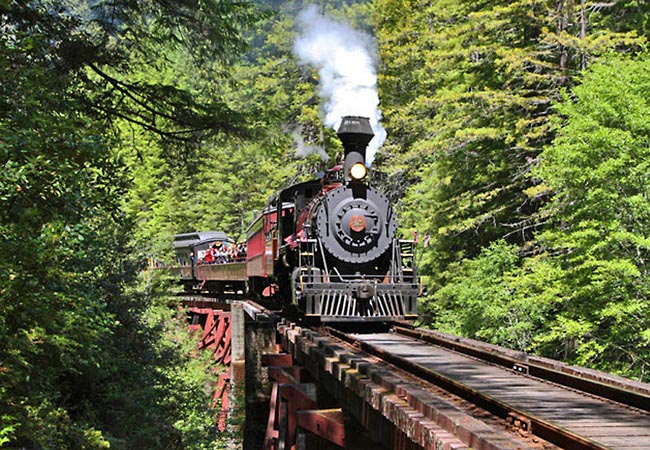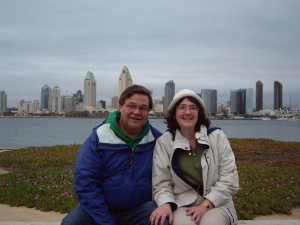
The Skunk Train – What a name for an excursion train! There’s no need to hold your nose as we’re welcomed aboard the Skunk Train for an unforgettable rail cruise through as second-growth redwood forest in California.
Watching Episode 31
The Skunk Train is one of the most popular train rides on the West Coast. In this episode we’ll see why. To watch Episode 31 of Ramping Up your English, click here.
View by Segment
You can view Episode 31 by segment, beginning with Segment One

Episode Details
We also ride train called the Surfliner to San Diego, the first Amtrak trip I took with my wife Liz. The photo on the right is from Coronado Island with San Diego in the background. The Surfliner is the first of 2 video clips we shared in Episode 31.
We travel from the California Coastal town of Fort Bragg, through a lush second-growth redwood forest, half the distance to Willits – a high, dry and usually hot California town.
This train is still pulled by a lively stream locomotive. We passed through this forest that was logged over 100 years ago. The railroad was first a logging railroad, cutting and supplying redwood lumber to San Francisco. After the timber was all gone, the railroad offered its employees the chance to own summer camps in the forest, most of it off the grid. There’s a Boy Scout Camp and another organizational camp along the rails. Access is via this train.

Boarding the Train
We boarded in Fort Bragg, and were soon told about the creek we followed. It’s called Pudding Creek. There’s no tasty pudding anywhere here. Early settlers put their small boats into the creek to float them to the ocean. The creek was thus called Put InCreek. Since it sounded a lot like “pudding,” the name changed over time. Hence the name Pudding Creek.
All in a Name
There was a running commentary about the history of the train and the area we were traveling through, so we learned a lot about redwood trees and about the train. As for the name, it wasn’t the steam engine that inspired the memorable but off-putting name of Skunk Train. On the second part of the trip to Willits, the part that continued past our turning-around spot, the railroad ran a single motorcar on the tracks. Think of a bus mounted on rail wheels, and you have a pretty close picture in your mind. This ran on a fuel that put off an unpleasant odor, and was thus referred to as the Skunk Train. Over time, the name stuck to the entire route of the train, which is now known as the Skunk Train.
Music: In this episode, we used the music of Greg Shindel by permission. If you’d like to order his fantastic CD of train songs, write to:
Schindel Music
P.O. Box 1370
Willits, CA 95490
Be sure to mention Ramping Up your English.
Videos Used in This Episode
The first video featured in Episode 31 is the California Surf-liner, a very scenic train by Amtrak. Click on Segment 2 above to see the video. I also found a video with no narration that features the Surf-liner. Click here to see the video.
You might not want to ride a train called the Skunk, but you’d be missing a ride ride if you refused. The video A Train Called the Skunk is part of this episode. Click here to watch it.
Language Objectives
Listening Comprehension – Using context clues and familiar vocabulary, retell the highlights of a journey featured in a video.
Academic Content Objectives
History: Identify the historical developments that led to the establishment of the California Western Railroad from Fort Bragg to Willits, California. Trace the development of the Skunk Train from timber harvest to tourist railroad. Science: List three characteristics of Redwood trees that explain their growth in this region. Describe the climatic elements that support the growth of Redwood trees.
Self Assessment: Below are some of the slides I shared with viewers on doing a self-assessment. Click on a slide to enlarge it and use the back arrow to come back to this page.
You don’t have to create a graph like this one, but graphing your progress in a good way to celebrate the progress you’re making in improving your listening comprehension proficiency.




Setting your Comprehension Level
You can try turning your back on the TV and seeing how much you comprehend without the visual context. In addition, you could also try a different video clip, one you saw in the past but which has not been seen recently. This could be a baseline to compare with a similar self-assessment during the next unit. The important thing is not to be discouraged. It’s natural that as you withdraw the context that has made the clips comprehensible, you’ll understand less. Nevertheless, I’m confident that watching these video clips with your attention on them has increased your comprehension in listening as well as reading and writing.
Next Episode
We close our unit on Trains and Railroads in the next episode. You can visit the Episode 32 page by clicking below.